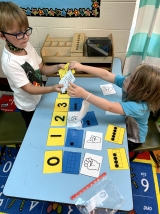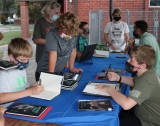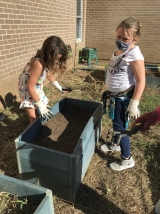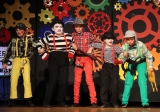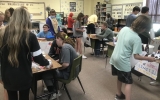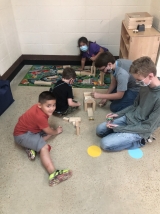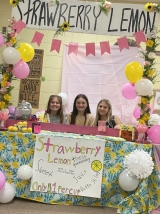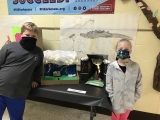-
Category 2
Selected in 2021
-
Grades: k - 6
School Setting: rural
Town Population: 645
Student Enrollment: 105
Student Demographics:
Black/African American: 5%
Teacher/Student Ratio: 1:15
White/Caucasian: 88%
Hispanic: 5%
Hawaiian/Pacific Islander: 0%
Asian: 0%
Native American: 1%
Other: 1%
% Reduced Lunch: 67%
% ELL Learners: 3%
Founded: 1883 -
PRINCIPAL:
Pamela Hogue -
CONTACT:
313 N. Garfield Street
Weiner, AR 72479
870-684-2252
phogue@hbgsd.org
Weiner Elementary School
Weiner, AR
We believe the greatest factor promoting change in our school is focusing on ways to reach our children."
- 1. Tell us about your school’s success.
-
We are entrusted with the possibility of what each child "could be." That commitment is seen in the humbling awards we received this fall:
High Overall Growth in Northeast Arkansas Region
High Math Growth in Northeast Arkansas Region
High ELA Growth in Northeast Arkansas Region
High Math Growth in State
High ELA Growth in State
High Overall Growth in State
Recognized by SOAR as a School on the Move
Overall ESSA School Index Score Increase
Weighed Achievement Increases
Value-Added Growth Increases
Best Growth Scores Overall by the University of Arkansas
Beating the Odds in ELA by the University of Arkansas
Beating the Odds in Math by the University of Arkansas
Although student achievement test scores may fluctuate slightly each year, scores are consistently in the high range.
Staff retention is a vital component that both contributes to our success and is, in itself, a measure of success. Our classroom teachers have been the same for six years. Almost all support staff have been here for a number of years as well. This continuity creates strong relationships, trust, and finds us celebrating each other's successes, as well as helping one another in ways both big and small. Jealousy, negative attitudes, excuses, and accepting defeat are completely foreign to us --we thrive through undivided support, positivity, the belief that there is always a way, and the shared goal that each of our students WILL possess command of the skills necessary to choose the life he/she dreams of and not one dictated by their circumstances.
Our school success would not be possible without our building principal, Pam Hogue, who understands she, too, is first a teacher, a motivator, and someone whose interaction with students, parents, and patrons cheerleads how remarkable our school is. There is a saying that goes, "People need to be reminded of what they already know." Ms. Hogue is seen everywhere in our community, talking about the wonderful things she sees students doing. It is not uncommon for Ms. Hogue to share strategies that we have found enhance student success with principals from other schools, as well. Micromanaging staff and an attitude of overseeing are not part of her leadership style. She makes certain each teacher and staff member has the best and most effective training available, the supplies they need to carry out instruction, and acknowledges the hard work she sees happening all around her. Ms. Hogue truly loves each person in the building. There are many times her eyes betray her by filling with tears when she thanks the staff and our students for how hard they work. Students believe they are important, valued, smart, and belong --her interaction with them builds a love for her within our children. As a result, we have very few discipline problems. No one wants to let down "Miss Pam." Our students know that they are not only respected but cared for, and their behavior and attitudes toward school and learning are in turn positively affected.
We believe that perhaps the most innovative and meaningful component of our success is our daily morning assembly that reveals the world to our students. We are in our eighth year of assembly. Our demographics are those that are sadly common in rural America. Many of our children live in poverty (about 67%). Their view of the world is limited to this small community. Assembly focuses on the amazing things in our world --it builds background knowledge and perhaps even more importantly, reveals to each student the wonder that is theirs. Assembly shows them the successes and the STRUGGLES of famous artists, gifted musicians and composers; they visit places around the world that shout of the talents and determination of architects and the miracle of nature itself. This coming together lays a fertile foundation for success --a reason to learn and work hard; it brings us together as an organic learning community composed of younger students, older students, and staff who learn together and marvel. We sing patriotic songs, talk about character words and how they help us; we learn about creativity, exploring the world, and discovering. We introduce students to previous Weiner Elementary students who have gone on to do remarkable things; this helps them understand that they can do those things too!
Morning assembly carries over into the regular classroom where students find ways to tie what they saw in assembly to their reasons for learning. Our kids know things other students --even many high school students do not know. They know how to sit still and be attentive in a large group because of assembly, developing skills that are valuable in a public setting. For example, when students went to Little Rock to see and hear a performance of the Arkansas Symphony Orchestra, they listened attentively and later asked thoughtful questions.
The daily slides for morning assembly are prepared by seven teachers who have faithfully fulfilled this role since its beginning in 2014. This involves research and group collaboration on the shared slides. Why all this so-called "extra work?" We have seen the results!
The success of our school is founded on relationships and hard work. Our success is based in believing each of us, teachers as well, have much yet to discover. Recently, we came together for a day of celebrating our hard work. As expected, it began at assembly. Students saw slides of each of the honors they have won this year. Our state representative spoke, congratulating them. They were given a t-shirt listing their honors. The rest of the day was spent in fun: outdoor games, cotton candy, blow-up jump houses and slides, a hayride, a magic show by an area magician, hot dogs with canned soft drinks! At the end of their day, thanks to the Endowment, each child was given a gift picked for them. Typically, students only see this type of celebrating for sports wins --this celebration was for hard work and academic achievement. - 2. Talk about the greatest contributing factor(s) that promoted positive change in your school.
-
We believe the greatest factor promoting change in our school is focusing on ways to reach our children living in poverty. Although it may not be a popular statement to make, it is true that poverty greatly influences academic success. Poverty affects other things, as well, that in turn feed into academic achievement.
Anytime we have visitors who want to learn about what we are doing, we have a group of four to six students take them around the building and talk about their school. The day before the visit, the student team meets with a teacher who prepares students about what to expect --how to introduce themselves and how to quietly go into classrooms for an observation. Recently, we had a visitor from the state reading initiative visit our school. This time, as we typically do, we had new student guides. Three of the four guides were children in poverty. One of the students asked the teacher if the visitors would ask them any questions. The teacher told them that might very well happen and not to worry about it because they knew all about their school. The student continued, "But what kind of things might they ask us?" The teacher replied, "The visitor might ask you something like, 'What helps you to learn and be successful in your class?'" Another student, a 4th grade boy whose story is heartbreaking and who lives with an uncle, quickly replied, "I know what I'd tell them. I'd tell them that at my other schools the teacher gave me so many new things to do that I was "overwhelmed" (his actual words). I was sure I couldn't do them. But here, the teachers give us fun activities to do first --activities that we really like. Then we learn how to do new things that are about the activity, and I'm excited and know I can do them then!" He chose to tell the visitor exactly that the next day --she told the principal about it. Children in poverty are making gains by experiencing activities BEFORE instruction.
Children in poverty are seen and actively involved in all aspects of our school. The percentage of children in poverty within our gifted and talented program increases each year. This year about 42% of identified students are on free and reduced lunch. Children are placed according to potential and to the answer to this question: "Is this child achieving at a level that is remarkable considering his/her opportunities?"
We have discovered that what is working to bring about a positive change for our children in poverty is extending mastery and excitement for learning with all students. Connecting learning to that which is real transforms learning apprehension to curiosity which does its work in each child. Students are reading novels in Science. They study energy by reading "The Boy Who Harnessed the Wind" --setting the stage for building their own working radio and a windmill that actually made a light bulb glow. In math, students may keep a glossary using a Frayer Model to define math terms and look for word and visual associations to better comprehend and remember the definition. Children see the development of food from seed to table by planting and maintaining a school garden complete with watering system. These same students took a field trip to see several food trucks and then returned to the classroom to create menus with prices and create a logo for an imagined food truck of their very own. Reading Relays find students paired in small groups to read a chapter together by taking turns and then answering discussion questions together --something students love that keeps them engaged regardless of reading level. The Academic Olympics involves students in teams that compete for gold, silver, and bronze medals. This week-long event tests knowledge of academic subjects previously studied and consists of a speed round of questions, individual rounds, and ends with a jeopardy type final question. Kids love this! Review becomes something they look forward to and provides yet another motivation for learning!
Students have participated in a postcard exchange, sharing information about their school and community with students in other states and providing a purpose for their writing. They also enjoyed the cards they received from other schools and learned about other places in our nation. At Thanksgiving, two classes joined together and prepared a meal of foods from different countries with the help of parents. Students first researched different countries to determine if they had a celebration of thanks. Students prepared their dishes in a large kitchen on campus and then shared the food with several classes.
Second grade students studied video techniques and created videos using stop motion. Their completed video projects were shared at assembly and on our school's social media, filling them with pride and the belief they might someday be an animator. This same group of students learned basic coding and developed pathways for the school robot to travel. Students enjoy working with a partner and in small groups, talking about what they are doing.
The school librarian connects students to positive experiences in the outside world such as arranging school visits from musicians or artists, educational field trips, virtual field trips, and virtual visits or digital interactions with professionals and students throughout the world. She promotes a love for reading through motivational programs and activities sponsored by the library, including reward programs that recognize reading achievement. The librarian helps all students achieve technology skills and confidence in using computers and helps them realize ways technology can help them communicate, gain knowledge, and create. (Thanks to the Endowment, we are a 1:1 technology school; K-2 have iPads, grades 3 & 4 have Chromebooks, and 5th and 6th have Macbooks.)
Focusing on ways to reach our children living in poverty has, indeed, been the greatest factor promoting change in our school, however that purpose and the resulting strategies and attitudes of our school's educators, and yes, students, affected all of our curriculum. - 3. How has ESEA funding supported the school's success?
- Much of our school’s success centers around our determination that each child will learn, that each child’s world will be expanded, and that each child will feel valued. ESEA funds pay for two instructional aides. The two instructional aides help classroom teachers provide the personalized remediation needed to meet kids where they are academically and to move them forward. The aides work under the direction of classroom teachers who are responsible for Tier I & II interventions, assisting those students to redirect and find success. ESEA funds also allow our school to employ a keyboarding teacher. Keyboarding, once only part of the realm of secondary schools, is used daily in our elementary school setting, and we consider it vitally important that our students learn the proper techniques of keyboarding and as much as possible about terminology and programs related to computer education. All of our students, grades Kindergarten through the sixth, have keyboarding classes which help unleash creativity for student projects and instills confidence during computerized achievement testing. Computer programs such as IXL and Newsela are paid for with ESEA funds. IXL not only evaluates students' academic strengths and weaknesses, but also acclimates children to the digital skills needed for the program and to the computer device itself, which reduces stress during achievement testing. Newsela is a software program that supplies nonfiction articles for reading practice. The program’s ability to present each nonfiction selection according to a student’s reading level provides valuable individualized reading practice for students. Technology has moved from a helpful addition to our educational program to a vital tool for meeting our school goals. Technology is used to connect our isolated, rural students to positive interactions with the outside world through virtual field trips, Skype sessions with professionals, online cultural events, and digital interaction with students in other locations. Typically, $5,000 of our school’s ESEA funds are used for technology equipment or software which helps us in our quest to help each child reach their full potential.
- 4. What professional development activities were used to improve teaching and learning?
-
While online learning seems to be the direction professional development is headed, teachers in our school find hands-on workshops the most beneficial. One teacher participated in a gardening/wildlife educator session at the Nature Center in a nearby park where she actually created the items that students would make in the classroom. The realization of how a steady learning environment of online learning can become tedious is, in itself, an extremely valuable lesson for us to remember and respect as we work with students. If teachers prefer hands-on learning, how much more so do students who need to move and interact? As a result, we are careful to vary the delivery of learning opportunities to honor the physical and emotional needs of children within their learning environment, while involving them in both hands-on and digital projects and learning.
RISE training, in combination with Connections for language arts has benefited our students enormously. Teaching young children how to read can be a daunting and overwhelming task. Our lower grade level teachers --even those with experience, found both of these trainings greatly helped them systematically develop successful decoding skills in new readers. RISE training goes beyond "what" to do, but effectively explains "how" children best learn to read, how to make it engaging, and the necessity of introducing Greek and Latin root words, which we are!
We have used IXL for several years, however the training we had this year showed us new methods and more efficient ways to track student progress. It helped us better tailor assignments to each student's needs.
All of us agree that our staff meetings are important in student success. Our principal values our time and directs anything that can be handled via an email be handled in that manner. Our meetings are for discussing potential problems or issues that affect all students so we can share ideas. This accomplishes two things: it provides us a unified solution and direction for a need, and it is the principal's way of involving us in the decision process of our building. This method builds collaboration and honors the opinions of teachers and staff. Even those things that are mandated, whether by the state or district, are discussed. Teachers receive all relevant information --typically understanding where and why new regulations are evolving enables us to embrace change and see the reasoning behind those changes. We use staff meetings to think of ways to reach specific students that may be struggling within the learning environment and even at home.
We know that what happens at home does affect learning at school.
Ruby Payne, in her studies of teaching children in poverty, often talks about the importance of educating the whole child --even family needs and socio-emotional needs, as well as other areas. It is within the professionalism of our staff meetings that we come together to consider ways to reach and support children whose home situations may be causing a change in their learning. We know that an abnormal reaction at school to an abnormal situation at home is, indeed, normal behavior. The question at that point is not how to fix the home, but how to provide the child the scaffolding he/she needs to function in the classroom. This can be a challenge. Each child is different, however our staff is small --we know each child. The ideas of other teachers, especially those who had the child previously, are invaluable in discovering ways to make school not just a predictable and safe place for that child, but a place the child finds caring and a sense of normal.
Several teachers expressed the idea that looping has in a sense been a very effective type of staff development. Our teachers have the same students for two consecutive years. This allows a teacher to know fully the individual strengths and weaknesses of each student the next year. They are then able to pick up right where they left off the previous year and continue to build. Teachers also believe that their knowledge of standards and strategies increases from teaching at the same grade level in concurrent years. This deepens both their skill and the mastery of what standards they are covering.
Teachers who teach different subjects at the same grade level share how valuable it is to have a teaching partner in order to create units of study that involve literacy, social studies, science, and math. These comprehensive units illustrate to students how all subjects depend upon each other.
Perhaps the most unusual type of professional development that has benefited us in our personal learning and continues to grow our closeness as a faculty are the summer trips we take together at places that are important in Arkansas history, culture, and other places (these are funded by the Endowment). Before we even return home, we are thinking of ideas and ways to make what we saw and experienced come to life for students. The places we visit and the people we meet, in turn, become some of the artists, musicians, and places of the week in assembly. Teachers are more credible to students when they know their teacher has actually been there. We are able to share photographs, involve them in meaningful discussion, and sometimes --if it isn't too far, take them on a field trip to see these places themselves. Over the past several years we have had overnight trips together as a faculty to northwest Arkansas and visited Crystal Bridges, the native American museum, and other points of interest. We have gone to Memphis and visited Beale Street Museum, the Elvis Presley home and museum, the Civil Rights Museum and other places. Together we spent two days at Mountain View Arkansas, touring the Folk Center and Blanchard Springs Caverns. We return home closer friends than we were before and ready to inspire students. - 5. Talk about the cultural shift leading up to your school's success.
-
We are well aware that our students are a generation of kids who find it difficult to believe that the world existed before Google, laptops, smartphones and tablets. Our students learn differently — not better or worse — but differently. New jobs are born everyday --today's nonexistent jobs are waiting for their time to emerge. It is also vital to get our girls and those in poverty interested in technology as creators and programmers. This, too, must begin at an early age. Problem solving, teamwork, effective communication skills, critical thinking, creativity, literacy, leadership, foreign languages and even emotional intelligence must become the norm. The so-called "soft skills" are a vital part of all instructional activities.
Thanks to the Weiner School Childrens' Endowment, we are a one-to-one school. Students utilize technology in the creative process, they know how to locate needed information, they know how to collaborate on a shared document or project, they are comfortable with multiple learning platforms. They utilize Google Classroom for assignments and are comfortable creating multiple types of projects utilizing digital tools such as Padlet, PhotoScissors, Word Clouds, DotStorming, Fotor, and others. They have learned and continue learning about being safe online through PearDeck interactive presentations and online sites such as Common Sense Media, PBS, and others. They independently utilize links to computer tutorials that are placed within their Google Classroom and enable them to problem solve what they do not know how to do. They have connected with other places and people through virtual meetings. Students have Skyped with authors of children’s books, with park rangers from national parks such as Yellowstone, with wildlife refuges, historical museums, and others. They understand how to evaluate websites, search for quality images, and how to cite resources. However, our students still enjoy hands-on learning that we have found partners well with digital learning and immerses students in the soft skills in ways we think are appropriate for children.
We have worked hard to create a type of cultural shift in literacy using different approaches than before to create readers out of kids who tend to prefer a steady diet of screentime. Examples of that include The Book Cafe that acquaints students with books they’ve never read and motivates a desire to read. At a mock restaurant, students sample different books as each “course” is served. The library is decorated as a restaurant with the books being the menu items. Students use the online program, Biblionasium, which is similar to a GoodReads program for kids. The students maintain a shelf of books they’ve read and would like to read and share titles and recommendations with each other. Rainbow Readers is a group of upper elementary students who produce video book reviews which are shared in assembly and on the library website and YouTube channel. The book reviews consist of a student-led interview with a student who has read a recommended book. The books reviewed rotate among different genres and age levels.
Perhaps, this teacher's explanation of how she encourages a cultural shift in attitudes within her students expresses another type of change that permeates our school: "My students know they are brilliant students. I ensure that they know they are capable of doing anything. I build their confidence as much as possible because at their age they need confidence. They need a teacher, but most importantly they need a cheerleader. My students then, in turn, build each other up. We are a school family and also a classroom family. They cheer each other on and support each other when they struggle, learning they are capable of more than they imagined. They have a say in their learning experiences whether it is allowing them to choose their own topics, projects, or even what to learn first. They have a say in how we go about our daily reading. When they have a voice, they are confident, empowered."
We also have carefully chosen learning activities that teach the heart. We want our students to see their power to effect good in the world, to see themselves in another. We are all too aware that many atrocities were perpetrated by highly educated individuals. This cultural shift leads to the greatest success for the well-being of others and encourages our students to view themselves as capable of effecting change by serving others. The Civil Rights Movement Project involved students in being changemakers. The purpose of the study was to nurture compassion and empathy for those students may view as "the other." Students chose a significant member of the Civil Rights movement and created a presentation on that person which they presented at assembly. They also chose a "changemaker" project which would create a positive change within our school or the community. Another project was a full-length theatrical performance of the childrens' opera, "Brundibar" which was performed numerous times by the children of Terezin. Students learned about risk-taking --none had ever seen an opera before and now they were performing one. They discovered the power of the art to teach and inspire. The performance was shared with area schools and was presented at the state P.T.A. Convention. This past year a novel writing project found twenty students meeting a weekly goal of 2000 words a week in their own individual anthropomorphic novel. The purpose was to change attitudes about writing, to nurture perseverance and hard work and to help students develop empathy by living in the hopes and fears of their characters. The novels were published by Lulu Publishing. Families ordered many copies of the books and additional copies of each student's novel are housed in the school and local town library. Students have had food drives for our community Little Free Pantry. Older students have listened to younger students read as "Reading Buddies." Our students actively experience the power and beauty of looking outside themselves in ways we believe will continue to influence them.
We see opportunities for cultural shifts all around us ...and tomorrow there are certain to be others. - 6. How has community involvement strengthened your success?
-
One of the most valuable factors in our school’s success is community involvement. Our community is an important part of our school, and our school is an important part of our community. Parents, grandparents, and community members generously donate time and money to our projects and programs. This support might include providing money for a low-socioeconomic child to spend at a Santa’s Workshop, providing meals for all on a field trip so that no one has a better meal than the other or goes without, setting up stations with treats during a school Fall Walk, or volunteering time to read aloud to a class. Our school classes, in turn, have led a drive to stock a local food pantry, honored community veterans in a special assembly, and participated in the area’s annual Rice Festival as well as other activities.
In 2015, the Weiner School Children’s Endowment was formed by citizens in our community for the sole purpose of providing extra financial support for our school’s endeavors. Just as most schools have sports or band booster clubs, the Weiner School Children’s Endowment (WSCE) works and has fundraisers but with the purpose of assisting our school’s educational program. Each year the WSCE has raised funds of $42,000 up to $77,175 annually through donations, fish frys, raffles, and other fundraisers. Funds from the WSCE have helped enable our school to have one-to-one computer devices for all grades, provided food for students who face food insecurity through our school’s “Backpack Program,” funded special field trips to hear an orchestra or see a play, paid for musicians and other special presenters to come to our campus, and allowed our school to purchase extra software programs that enhance our curriculum. Our citizens are proud of their school and feel a sense of ownership concerning it. Just as one wants to keep family informed of his or her activities, our school attempts to keep local community members and graduates enlightened about our activities, events, and awards through an active Facebook account. The principal and all teachers regularly post information and photos about what is currently taking place in the school and particularly in the classrooms. These postings keep our patrons interested and allow them to see how their personal work, money, and time are making a difference for our school.
Stats
-
Category 2
Selected in 2021
-
Grades: k - 6
School Setting: rural
Town Population: 645
Student Enrollment: 105
Student Demographics:
Black/African American: 5%
Teacher/Student Ratio: 1:15
White/Caucasian: 88%
Hispanic: 5%
Hawaiian/Pacific Islander: 0%
Asian: 0%
Native American: 1%
Other: 1%
% Reduced Lunch: 67%
% ELL Learners: 3%
Founded: 1883 -
PRINCIPAL:
Pamela Hogue -
CONTACT:
313 N. Garfield Street
Weiner, AR 72479
870-684-2252
phogue@hbgsd.org


